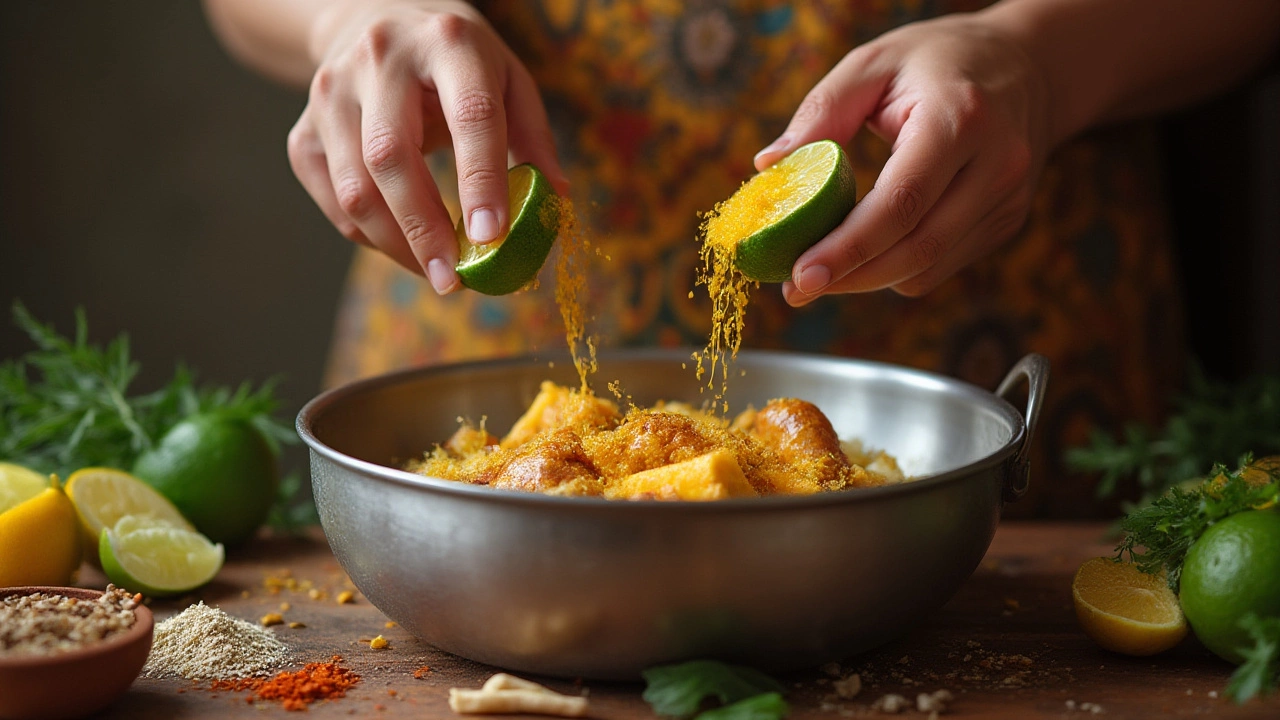Ever bite into a grilled chicken and wonder why it’s bursting with flavor, all juicy and tender? Would you believe the magic often starts hours before the grill even gets hot? Foodies, home cooks, and the occasionally kitchen-curious have all tried to “marinate” something, but few actually know what makes a good marinade tick. Secret’s out: among dozens of spices, herbs, oils and tangy sauces, there’s one absolute key ingredient. This one thing can make sure those flavors don’t just sit on the surface but dive right into the heart of your meal. You might think it’s salt, or oil, or garlic, but science (and your taste buds) will say otherwise.
The Science of Marinades: Why One Ingredient Does the Heavy Lifting
Let’s get right to the point—acid is the key ingredient in any great marinade. Yes, acid. Think vinegar, lemon juice, yogurt, buttermilk, wine, or even pineapple juice! These are what really get things happening under your food’s surface. Why? Because acid starts breaking down tough protein structures in meat, fish, and even vegetables. That break-down lets other delicious flavors seep in deeper. When you skip the acid, your marinade won’t get past the outer layer. More than that, acid brings zing and brightness, waking up your palate in ways plain old salt or oil simply can’t.
But don’t just take my word; there’s some actual science behind it. For example, when you marinate tough cuts like flank steak or chicken breasts, the acid starts to unwind those tightly-wound muscle fibers—a process called denaturing. If you look at a lab study (like the one from the American Meat Science Association in 2018), you’ll see a measurable difference in tenderness and juiciness between marinated and non-marinated meats, with acid-based marinades leading the pack. So acid isn’t just about flavor—it’s about texture, too.
Of course, this doesn’t mean you flood your meat or tofu in lemon juice and call it a day. Too much acid can turn things mushy or even toughen proteins if left too long. It’s a balance: a typical ratio might be 3 parts oil to 1 part acid, plus your spices, garlic, chilies, or herbs for that personal flair. If you look at how classic cuisines approach marinade, that formula holds up. Indian tikka uses yogurt (mild acid), Greek souvlaki leans on lemon, and many Southeast Asian dishes use rice vinegar or lime. Each brings its unique profile, but acid is always there, balancing and unlocking those flavors.
A quick look at the effect of popular acids, according to a food chemistry study:
| Marinade Acid | Common Use | Flavor Notes | Best For |
|---|---|---|---|
| Lemon Juice | Classic in seafood, poultry | Bright, tangy | Fish, chicken, salads |
| Vinegar | Pickles, BBQ sauces | Sharp, pungent | Pork, beef, vegetables |
| Yogurt/Buttermilk | Indian, Middle Eastern | Mild, creamy, tangy | Lamb, chicken |
| Pineapple Juice | Hawaiian, tropical | Sweet, fruity | Pork, shrimp, beef short ribs |
| Wine | French, Mediterranean | Robust, subtle sweetness | Beef, mushrooms |
Notice how every classic cuisine uses acid differently, but it’s always part of the base. No traditional marinade ever leaves it out.

Building the Perfect Marinade: The Role of Each Element
Think of marinade as more than just acid, though. Acid is the starter, but the real flavor party happens when you bring balance. Here’s how homemade marinades typically break down:
- Acid: The key tenderizer and flavor carrier (lemon juice, vinegar, yogurt, wine, etc.).
- Fat: Oils (like olive, sesame, or canola) help round out sharp acids, carry fat-soluble flavors into the food, and provide moisture. Oil also helps things like garlic, pepper, and herbs stick evenly to the surface.
- Salt: It’s the silent worker, helping both with seasoning and pulling out moisture. That actually helps the marinade get a bit deeper into the food structure, sort of turbocharging the acid’s effect.
- Sweetener: Sugar, honey, maple syrup, or fruit juice cut through the acidity and help form a delicious caramelized crust when you cook. That’s why you see honey in BBQ or brown sugar in teriyaki.
- Flavorings: This is where you play—think garlic, onion, ginger, spices, dried herbs, fresh chilies, soy sauce, mustard, and so on. These bring personality and regional flair.
Ready to make your own marinade? Try the “1-3-1-1” rule: 1 part acid, 3 parts oil, 1 part sweetener (optional), 1 part seasoning. Let’s say you want to make a simple chicken marinade for grilling. Mix 2 tablespoons lemon juice (acid), 6 tablespoons olive oil (fat), a teaspoon honey (sweet), a pinch of salt, pepper, garlic, and fresh oregano (seasonings). For every pound of meat, about ½ cup of marinade does the job—enough to coat but not drown.
How long to marinate? Here’s where people get confused. Acids go to work fast, so seafood might need just 15-30 minutes, chicken or thin beef cuts can go for 1 to 2 hours, and tougher cuts (brisket, beef short ribs) benefit from 4 to 12 hours. Beyond that, you risk breaking down the proteins too much, and things can get mushy and weird. Keep an eye on the clock and always marinate in the fridge, never on the counter.
Some quick pro tips:
- Use a zip-top bag or a glass/ceramic bowl for marinating—metal can react with the acid and ruin flavor.
- Pat meat dry before cooking—too much moisture keeps it from browning.
- Don’t reuse marinade unless you boil it first to kill bacteria.
In a 2021 survey by Bon Appétit, lemon juice and vinegar topped home cooks’ list of favorite marinade ingredients. But yogurt and buttermilk have loyalties in Indian kitchens for good reason—they gently break down proteins without turning meat mushy and have their own probiotics that add flavor.
When it comes to veggies, something like balsamic vinegar is perfect for eggplant or mushrooms, while citrus brightens zucchini or asparagus. A tablespoon of miso or soy sauce can add savory umami for tofu and plant-based proteins. Try tossing portobello mushrooms in olive oil, balsamic vinegar, garlic, a pinch of salt, and let them soak for 30 minutes before grilling. You’ll be amazed at the depth of flavor.
One fun fact: Studies show that marinating doesn’t actually penetrate deeply into thick cuts—a quarter inch or so is typical—so for really thick proteins, poke small holes or score the surface lightly for deeper flavor.

Common Marinade Myths and Mistakes: What to Avoid for Best Results
There’s a lot of bad info floating around about marinades. One myth I hear all the time is that "the longer you marinate, the better." Sorry, that doesn’t always hold. Leave chicken in a pure acid bath for 24 hours, and it’ll turn chalky—nobody wants that. Timing is everything. If you’re tight on time, even a half-hour soak with the right balance of acid and seasonings can work wonders, especially for thin cuts of meat or fish.
Another mistake is thinking you have to use a ton of ingredients. A good marinade can be as simple as three things: oil, acid, and salt. Fancy is fun, but keeping it simple gives you a solid flavor base, plus more control over what you’re actually tasting. For example, a traditional Greek souvlaki marinade is usually just lemon juice, olive oil, garlic, oregano, and salt. Simple and unbeatable.
Some folks also believe that salt in the marinade will dry out their meat. Actually, salt can draw in liquid at first, but over time, it starts to help the meat reabsorb marinade, pulling juice and flavor inside. That’s why a little salt up front is a good thing. Just don’t oversalt—a heavy hand can toughen the food’s texture.
There’s also debate about oil. Many cuisines use oil, but it’s not always essential. Too much oil can actually keep the acid and flavors from reaching the food’s surface. Stick with that 3:1 ratio of oil to acid, or even a bit less oil for lean items like shrimp or fish. Conversely, for something very lean (like chicken breast), a bit more oil can help with moisture loss on the grill or in the oven.
Food safety needs mentioning—never use leftover marinade as a sauce for brushing or serving without bringing it to a rolling boil first. That marinade has been in contact with raw meat, which can carry bacteria. A quick boiling transforms it into a safe glaze or drizzle, or better yet, reserve a portion before marinating for use as a sauce later.
Let’s talk about the "fork test." Some people jab chicken or steak all over to let the marinade in. It’s true that scoring or poking can help, but don’t go overboard—too many holes, and the juices leak out during cooking, leaving you with dry meat. Lightly scoring thick cuts, like beef or pork shoulder, works best. For delicate proteins (like fish), no poking is needed.
If you want a foolproof guide, here’s a basic table on marination time and ratios:
| Food | Recommended Acid | Ratio (oil:acid) | Time (in fridge) |
|---|---|---|---|
| Fish/Shrimp | Citrus/Lime Juice | 2:1 | 15-30 min |
| Chicken | Yogurt/Lemon/Vinegar | 3:1 | 1-4 hrs |
| Beef | Wine/Vinegar | 4:1 | 2-12 hrs |
| Vegetables | Balsamic Vinegar/Lemon Juice | 2:1 | 30-60 min |
So what about marinades without acid? Technically, you can call them spice rubs or oil-basts, but they don’t deliver the same penetration or textural improvements. If you ever taste grilled kebabs that are bland in the middle, it’s likely because the marinade missed that zippy acid kick.
If you enjoy cooking experiments, try swapping acids to see the impact. Vinegar adds a bite, lemon a bright citrusy hit, yogurt a creamy tang, and pineapple juice brings sweetness plus an enzyme that tenderizes protein (watch out: pineapple works fast, or things will get mushy!). Flavors will change, but the science—acid as the backbone—stays the same.
Want to take your marinade game up a notch? Try this trick from professional chefs: make your marinade, and let the acid and seasoning steep together for 10-15 minutes before adding to your food. This lets flavors meld, fills your kitchen with a delicious aroma, and boosts taste. And don’t forget—taste your marinade before using it. If it tastes dull or flat now, it won’t lift your food later.
So next time you reach into the fridge for that bottle of store-bought marinade, take a peek at the label—there’s always an acid up near the top. No acid? Put it back and make your own. Because once you know how important it is, you’ll never skip acid in your marinade again. And if your grilled chicken still comes out bland, now you know where to start tweaking.
